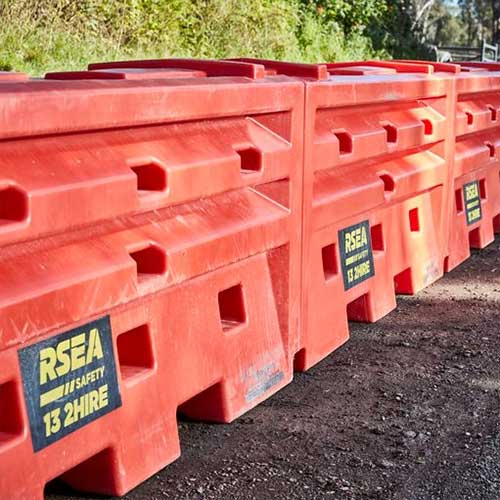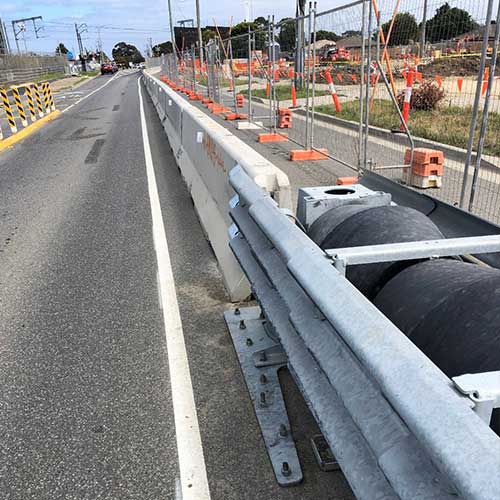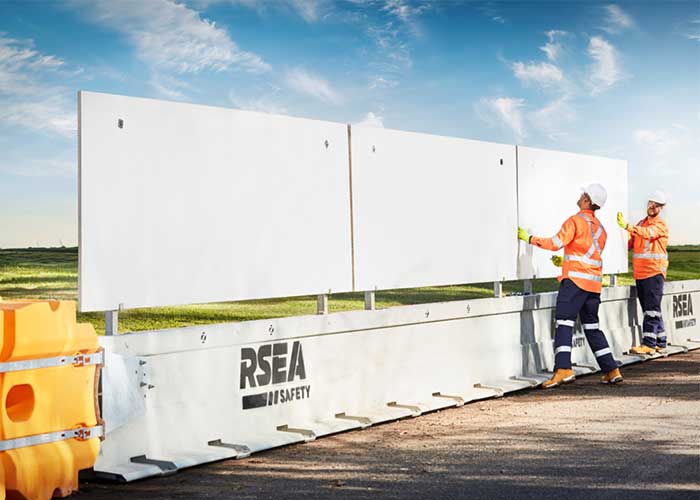Plastic vs Concrete vs Steel? How to choose the right barrier for your next project?
As temporary barrier and roadside safety experts, RSEA Safety Hire is regularly asked to provide guidance regarding suitable temporary safety barrier types for specific project requirements. Here is a quick and easy guide to assist you in making well-informed decisions.
Types of temporary safety barriers
MASH-rated road safety barriers are the only barriers approved for use on Australian and New Zealand roads. There are three accepted types of temporary roadside safety barriers available for use in Australia and New Zealand:
- Concrete
- Plastic water-filled
- Steel
When to use plastic water-filled barriers
Plastic water-filled barriers are typically made of highly durable polyethylene plastic and sometimes reinforced with steel cables to minimize vehicle penetration into a workzone. They have interlocking mechanisms to connect units to each other, typically steel pins. Once in situ, they must be filled with water which serves as a ballast to perform as designed. Additionally, plastic water-filled barrier runs must be installed with the appropriate end terminals for it be a compliant installation.
Water filled barriers are designed for:
- Low road-speed scenarios typically around 40-50kmh (but no higher than 70kmh depending on the barrier’s approval level)
- Low traffic areas where work is not required to be conducted close to the carriageway.
- Shorter-term mobile urban works and arterial roadwork due to their light weight, as they can be emptied and moved around easily without any specialised mechanical lifting required. Additionally, plastic water-filled barriers have good turning radiuses, helping in urban zones.
At RSEA Safety Hire, we stock the MASH-rated Lo-Ro water-filled barriers. These are, by a considerable margin, the safest plastic water-filled barriers available offering the best deflections in the market, as well as shorter clear zones and minimum lengths. Lo-Ros are approved to TL-1 & TL-2 test levels, meaning they can be use with road speeds up to 70kmh.

When to use concrete barriers
Temporary concrete safety barriers are made of concrete usually with an internal reinforced steel structure and connected using interlocking mechanisms. In temporary roadwork scenarios, they are installed free-standing relying on their heavy weight to provide the necessary ballast to perform as designed. They must be installed with appropriate end terminals for a compliant installation.
Concrete safety barriers are ideal for
- Low to medium speed roads in urbanized and arterial road areas where anchoring can be difficult due to underground services near the road surface. Some concrete barriers are rated up to 100kmh and can be used in scenarios where roadwork is not conducted near the barrier.
- Medium to long-term projects with multiple road switches.
Concrete safety barriers are part of our fleet at RSEA Hire, complementing our range of steel and plastic water-filled barriers. At RSEA Safety Hire, we carry both T-Lok barriers as well as DB80 barriers.

When to use steel barriers
Steel temporary safety barriers are made of steel with interlocking mechanisms at the ends. They are typically anchored into the ground using either asphalt pins, threaded rod with epoxy or with screw bolts. They must be installed with the appropriate end terminals for a compliant installation.
Steel safety barriers are designed for:
- High-speed, high-volume traffic areas up to 100kmh, therefore making them suitable for highway roadwork.
- Urban services work where limited carriageway width and mandatory lane widths leave limited space for the work zone
- Any application where low deflection is critical when work is being conducted close to the carriageway.
Steel barriers like Zoneguard® are ideal for rapid deployment and offer the lowest cost of transport of all safety barriers – typically around 1/3 of the transport cost of concrete. Steel barriers are considered a “semi-rigid” system which dissipates impact energy more effectively than concrete, resulting in less damage to errant vehicles. The greatest advantage of steel is its low deflection, however to achieve this characteristic the barrier must be anchored into the ground which is sometimes not an option when underground services are close to the road surface.
At RSEA Safety Hire, we carry the largest hire fleet of Zoneguard® steel safety barriers in Australia. Zoneguard is MASH TL-3 rated meaning that it is rated for road speeds up to 100kmh. Recently Zoneguard has been awarded MASH TL-4 rating, meaning that it is rated for impacts with 10 tonne vehicles at 90kmh. Zoneguard was one of the first steel barriers to enter the Australian market, and it is still the leading barrier in terms of deflection performance. Additionally, our fleet of Zoneguard barrier is complemented with a large array of ancillary equipment, including anti-gawk screen, shorter sections, fixed angles and adjustable angles and gating options. This gives our fleet a significant advantage over other steel barrier suppliers in terms of installation flexibility, such as in achieving tighter radiuses, facilitating off-ramps, and allowing for gates/access points.

In summary, each barrier type has particular attributes and design characteristics that make it ideal for specific conditions, but unsuitable for other scenarios. The key is understanding what barrier is suited for what condition. The below table summarizes the key points made in this article:
|
Barrier Type
|
Key attributes
|
Suitable conditions
|
Considerations
|
|
Plastic water-filled
|
Free-standing, lightweight, easy to move around, good turning radius.
|
Low speed, low traffic urban areas for short-term projects.
|
Appropriate for low road speeds only. Poor deflection compared to other safety barriers, thus not suitable when works are conducted close behind the barrier.
|
|
Concrete
|
Free-standing barrier providing reasonable deflection performance for situations where anchoring is not possible.
|
Low to medium speed roads in urban environments and arterial roads with underground services near road surface. Medium to long-term projects with road switches.
|
Very heavy, thus transport and installation costs are higher.
|
|
Steel
|
Excellent deflection performance, lightweight and efficient to install, low transport costs.
|
High-speed roads and high-traffic areas and where work is conducted close to carriageway. Medium to long-term projects.
|
Not suitable in situations where underground services are close to the surface.
|
At RSEA Hire, we have an inhouse team of barrier and road safety experts that can help work with you to determine the type of barrier ideally suited to your project requirements. Reducing roadside fatalities is a key mission at RSEA Safety Hire, and we are aware that for any safety barrier to provide its designed safety performance, it must be installed correctly. At RSEA Safety Hire, we provide full installation services ensuring the barriers are installed correctly according to state road authority approvals and manufacturer’s instructions. That way, you can rest assured that these barriers will perform as intended.
Contact your local team of RSEA Hire barrier experts for any further information.
Send a Quote request HERE or call us on 132 447